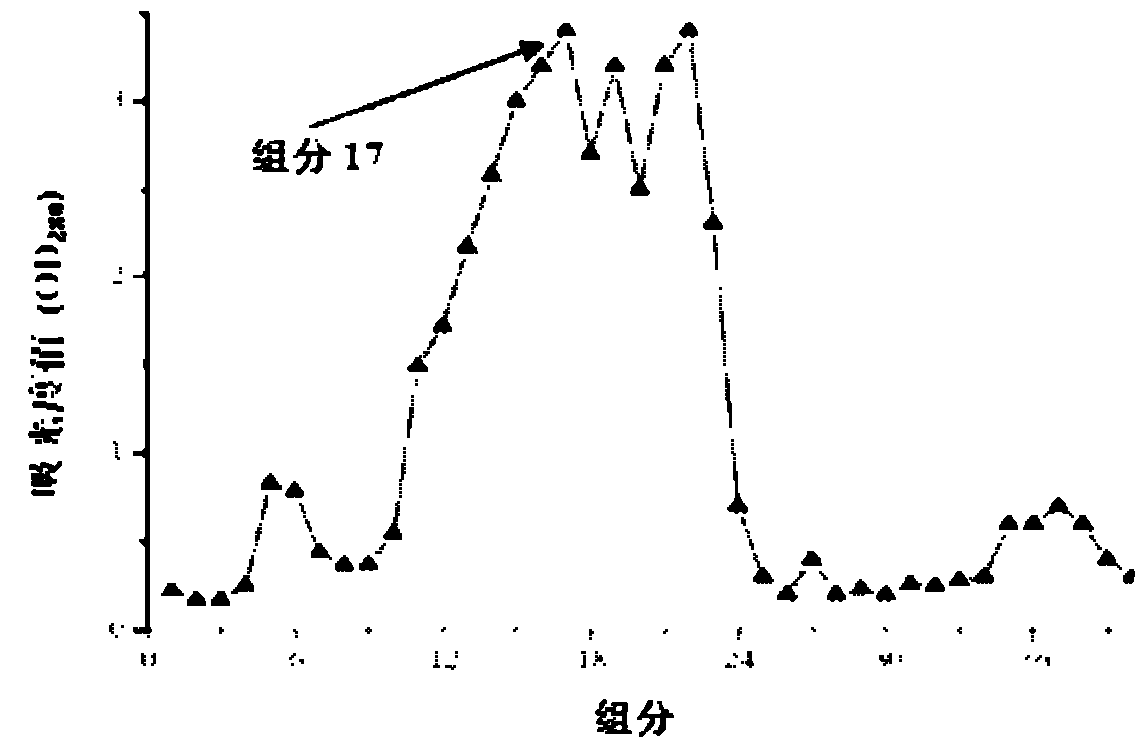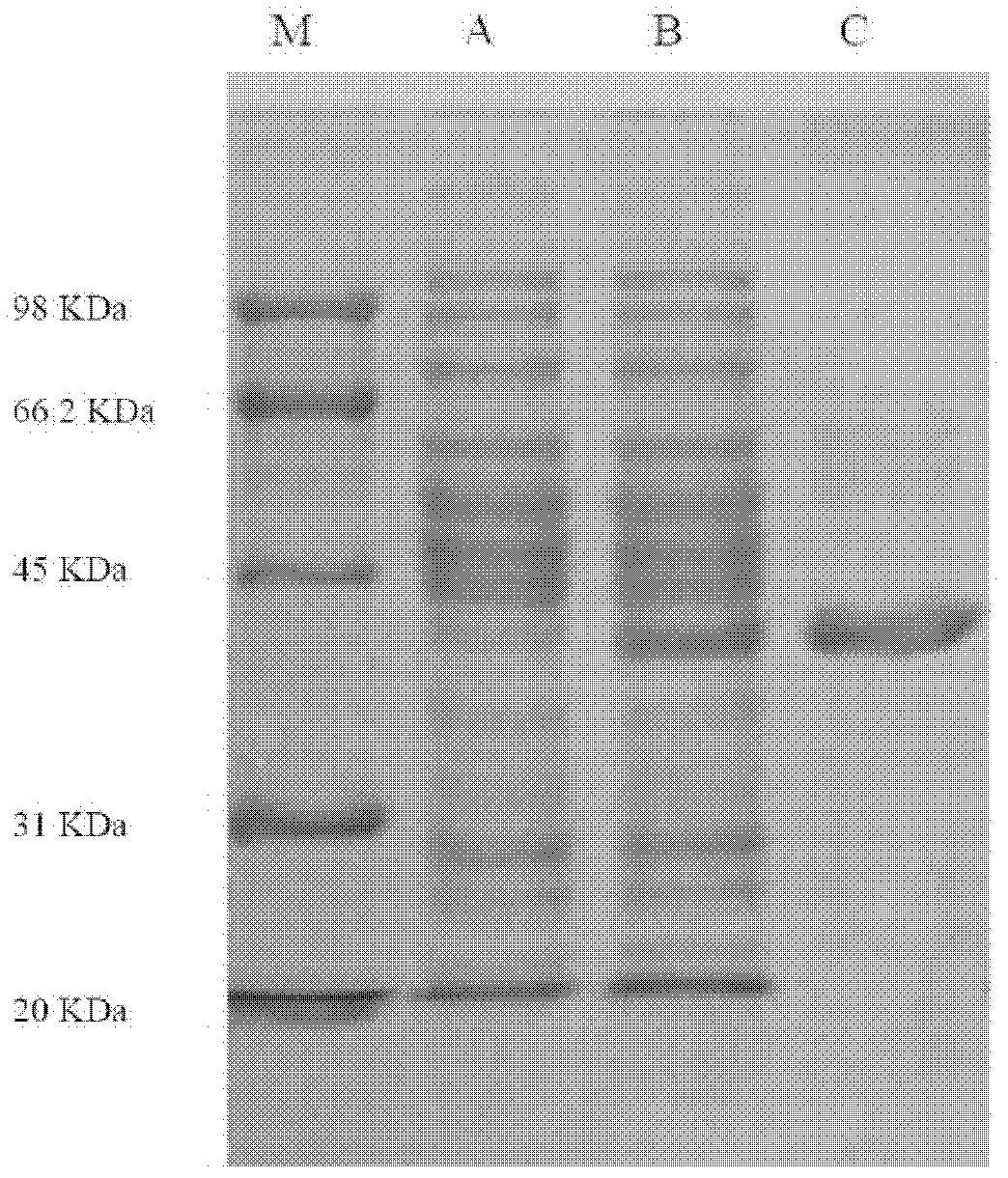Zearalenone (ZEN) toxin degrading enzyme for acinetobacter and coding gene and applications of ZEN toxin degrading enzyme
A technology of coding genes and degrading enzymes, which is applied in the field of zearalenone toxin degrading enzymes and their coding genes and applications, can solve the problems of Acinetobacter ZEN degrading enzyme gene sequence has not been reported and applied for patents, and achieve strong degradation effect of ability
- Summary
- Abstract
- Description
- Claims
- Application Information
AI Technical Summary
Problems solved by technology
Method used
Image
Examples
Embodiment 1
[0034] The preparation of Acinetobacter ZEN degrading enzyme comprises the following steps:
[0035] (1) Purify ZEN-degrading enzyme from Acinetobacter sp.SM04 culture supernatant
[0036] 1. The culture (M1 medium) inoculated with 1% (v / v) Acinetobacter sp.SM04 bacterial suspension (OD600=0.8) was cultivated (200r / min) in an air bath shaker at 30°C for 36h to the right At the end of growth, centrifuge the liquid culture for 5 min (12000×g, 4°C), filter the centrifuged supernatant with a 0.22 μm filter membrane, and concentrate the filtrate 5 times at 50°C using a vacuum rotary evaporator;
[0037] The formulation of the medium used is as follows:
[0038] Basic inorganic salt medium: 3g NH 4 NO 3 , 1.5g K 2 HPO 4 ·3H 2 O, 1g KCl, 0.5gMgSO4·7H 2 O, 0.1g CaCl 2 After mixing with 10mL trace element stock solution, add deionized water to make up to 1000mL, pH7.3.
[0039] Trace element stock solution: 2g / L FeSO 4 ·7H 2 O, 0.4g / L MnSO 4 4H 2 O, 0.4g / LCuSO 4 ·5H 2 O,...
Embodiment 2
[0053] Efficiency detection of ZEN degrading enzyme degrading ZEN
[0054] Based on the ZEN degrading enzyme activity assay method in the embodiment 1 step (1), get the ZEN degrading enzyme finally obtained in the embodiment 1 step (1), measure the content change of ZEN in the treatment solution under different treatment times, the results are shown in figure 2 .
[0055] from figure 2 It can be seen that the purified ZEN-degrading enzyme utilizes H 2 o 2 The degradation rate of oxidative degradation of ZEN is relatively slow, and more than 90% of ZEN can be degraded within 12 hours. According to the slope, the rate of oxidative degradation of ZEN is about 1.6μgmL -1 h -1 .
Embodiment 3
[0057] Detection of estrogenic activity of products degraded by ZEN degrading enzymes
[0058] With 0.40mL of the ZEN degrading enzyme finally obtained in step (1) of Example 1, 0.10mL of 0.25mol / L Tris-HCl (pH8.5) buffer and 20μL of 0.5mol / L H 2 o 2 The solution was mixed evenly, 10 μL of ZEN methanol stock solution (1 mg / mL) was added, incubated in a constant temperature water bath at 40° C. for 12 hours, and 0.5 mL of methanol was added to terminate the reaction.
[0059] The above reaction products (ie, the experimental group) were used to test the proliferation rate of MCF-7 cells. With the treatment group without ZEN and ZEN solution (10 μL 1mg / mL ZEN methanol stock solution mixed with 0.14mL 0.25mol / LTris-HCl (pH8.5) buffer and 20μL 0.5mol / L H 2 o 2 solution mixed uniformly) was used as the control group.
[0060] MCF-7 human breast cancer cells were purchased from the Cell Bank of the Chinese Academy of Sciences. For the experimental method of MCF-7 human breast c...
PUM
 Login to View More
Login to View More Abstract
Description
Claims
Application Information
 Login to View More
Login to View More - R&D
- Intellectual Property
- Life Sciences
- Materials
- Tech Scout
- Unparalleled Data Quality
- Higher Quality Content
- 60% Fewer Hallucinations
Browse by: Latest US Patents, China's latest patents, Technical Efficacy Thesaurus, Application Domain, Technology Topic, Popular Technical Reports.
© 2025 PatSnap. All rights reserved.Legal|Privacy policy|Modern Slavery Act Transparency Statement|Sitemap|About US| Contact US: help@patsnap.com



